Community Assessment and Diagnosis: First Nation Diabetes Disparities
VerifiedAdded on 2022/08/21
|13
|3425
|13
Report
AI Summary
This report presents a partial community health assessment focusing on the First Nation population and their disproportionate burden of diabetes. Utilizing the Population Health Promotion (PHP) model, the assessment examines three key determinants of health: income and social status, education, and physical environment. The report begins with an overview of demographic and epidemiological data, highlighting challenges such as lower employment rates, educational attainment, and access to green spaces. The analysis reveals gaps in employment policies, educational opportunities, and environmental factors, leading to a community diagnosis of health disparities. The report suggests the need for increased investment in employment opportunities, literacy skills, and infrastructure development to address socioeconomic disparities and improve health outcomes. Data from this assessment demonstrates the importance of addressing these health determinants to improve health outcomes for the First Nation population.
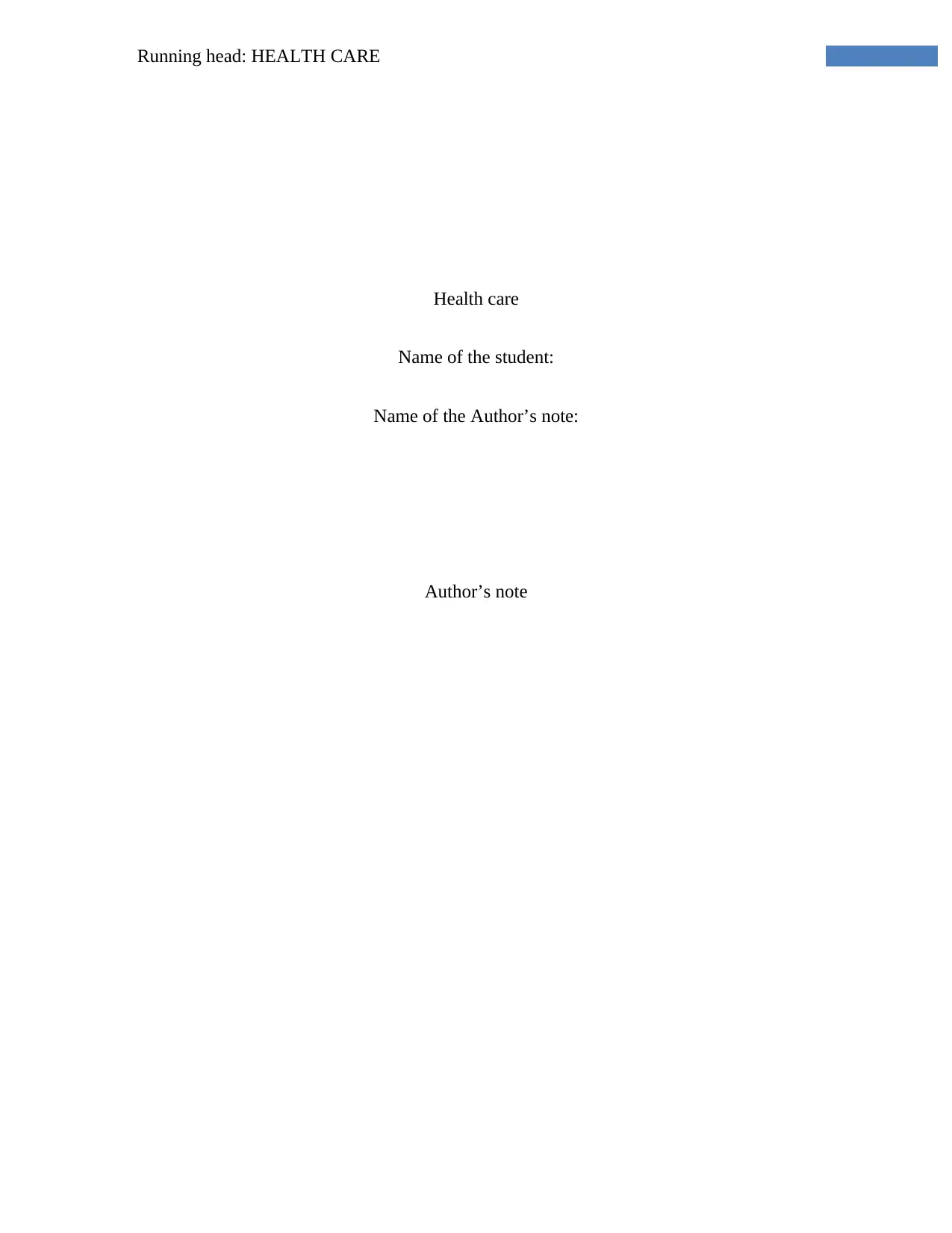
Running head: HEALTH CARE
Health care
Name of the student:
Name of the Author’s note:
Author’s note
Health care
Name of the student:
Name of the Author’s note:
Author’s note
Paraphrase This Document
Need a fresh take? Get an instant paraphrase of this document with our AI Paraphraser
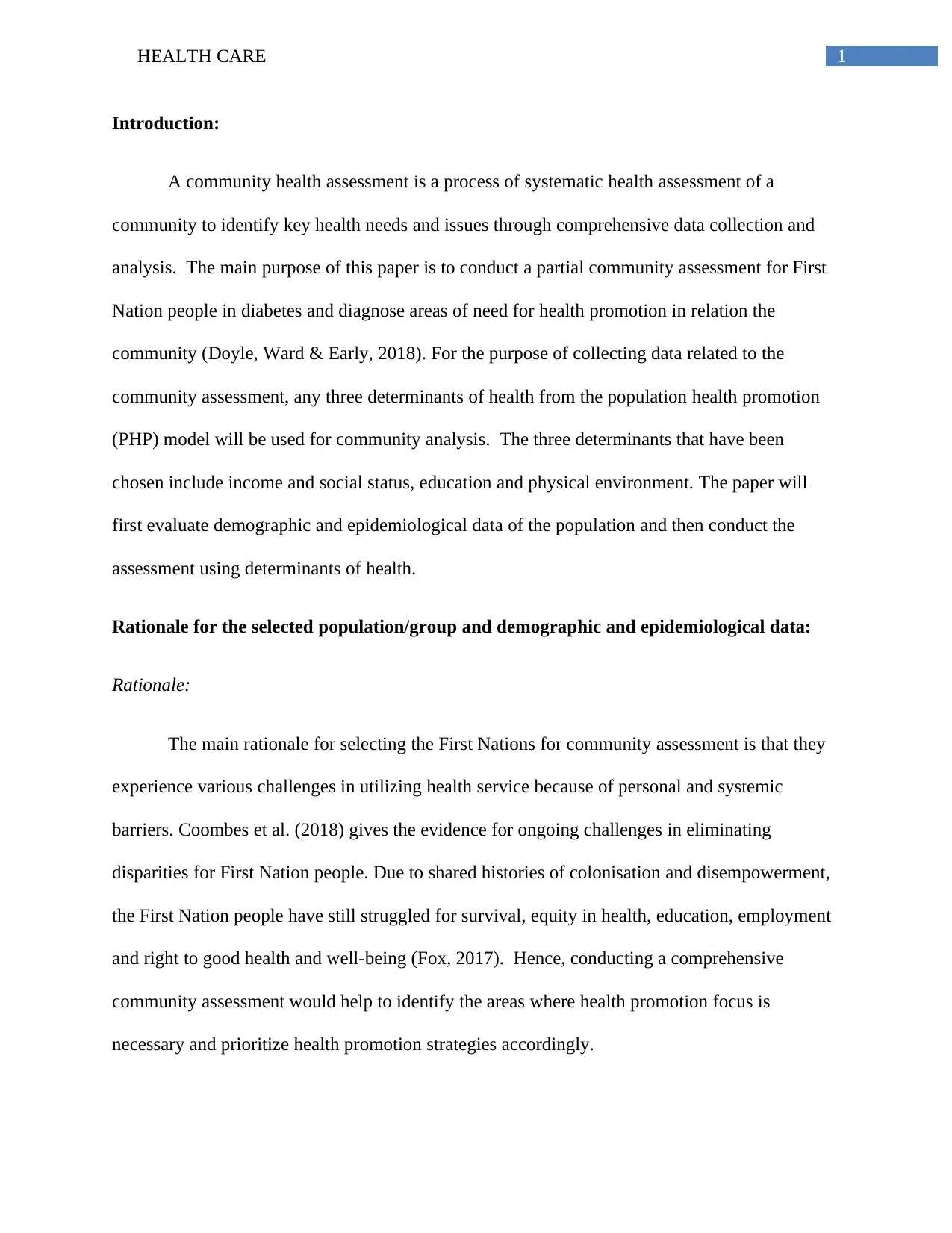
1HEALTH CARE
Introduction:
A community health assessment is a process of systematic health assessment of a
community to identify key health needs and issues through comprehensive data collection and
analysis. The main purpose of this paper is to conduct a partial community assessment for First
Nation people in diabetes and diagnose areas of need for health promotion in relation the
community (Doyle, Ward & Early, 2018). For the purpose of collecting data related to the
community assessment, any three determinants of health from the population health promotion
(PHP) model will be used for community analysis. The three determinants that have been
chosen include income and social status, education and physical environment. The paper will
first evaluate demographic and epidemiological data of the population and then conduct the
assessment using determinants of health.
Rationale for the selected population/group and demographic and epidemiological data:
Rationale:
The main rationale for selecting the First Nations for community assessment is that they
experience various challenges in utilizing health service because of personal and systemic
barriers. Coombes et al. (2018) gives the evidence for ongoing challenges in eliminating
disparities for First Nation people. Due to shared histories of colonisation and disempowerment,
the First Nation people have still struggled for survival, equity in health, education, employment
and right to good health and well-being (Fox, 2017). Hence, conducting a comprehensive
community assessment would help to identify the areas where health promotion focus is
necessary and prioritize health promotion strategies accordingly.
Introduction:
A community health assessment is a process of systematic health assessment of a
community to identify key health needs and issues through comprehensive data collection and
analysis. The main purpose of this paper is to conduct a partial community assessment for First
Nation people in diabetes and diagnose areas of need for health promotion in relation the
community (Doyle, Ward & Early, 2018). For the purpose of collecting data related to the
community assessment, any three determinants of health from the population health promotion
(PHP) model will be used for community analysis. The three determinants that have been
chosen include income and social status, education and physical environment. The paper will
first evaluate demographic and epidemiological data of the population and then conduct the
assessment using determinants of health.
Rationale for the selected population/group and demographic and epidemiological data:
Rationale:
The main rationale for selecting the First Nations for community assessment is that they
experience various challenges in utilizing health service because of personal and systemic
barriers. Coombes et al. (2018) gives the evidence for ongoing challenges in eliminating
disparities for First Nation people. Due to shared histories of colonisation and disempowerment,
the First Nation people have still struggled for survival, equity in health, education, employment
and right to good health and well-being (Fox, 2017). Hence, conducting a comprehensive
community assessment would help to identify the areas where health promotion focus is
necessary and prioritize health promotion strategies accordingly.
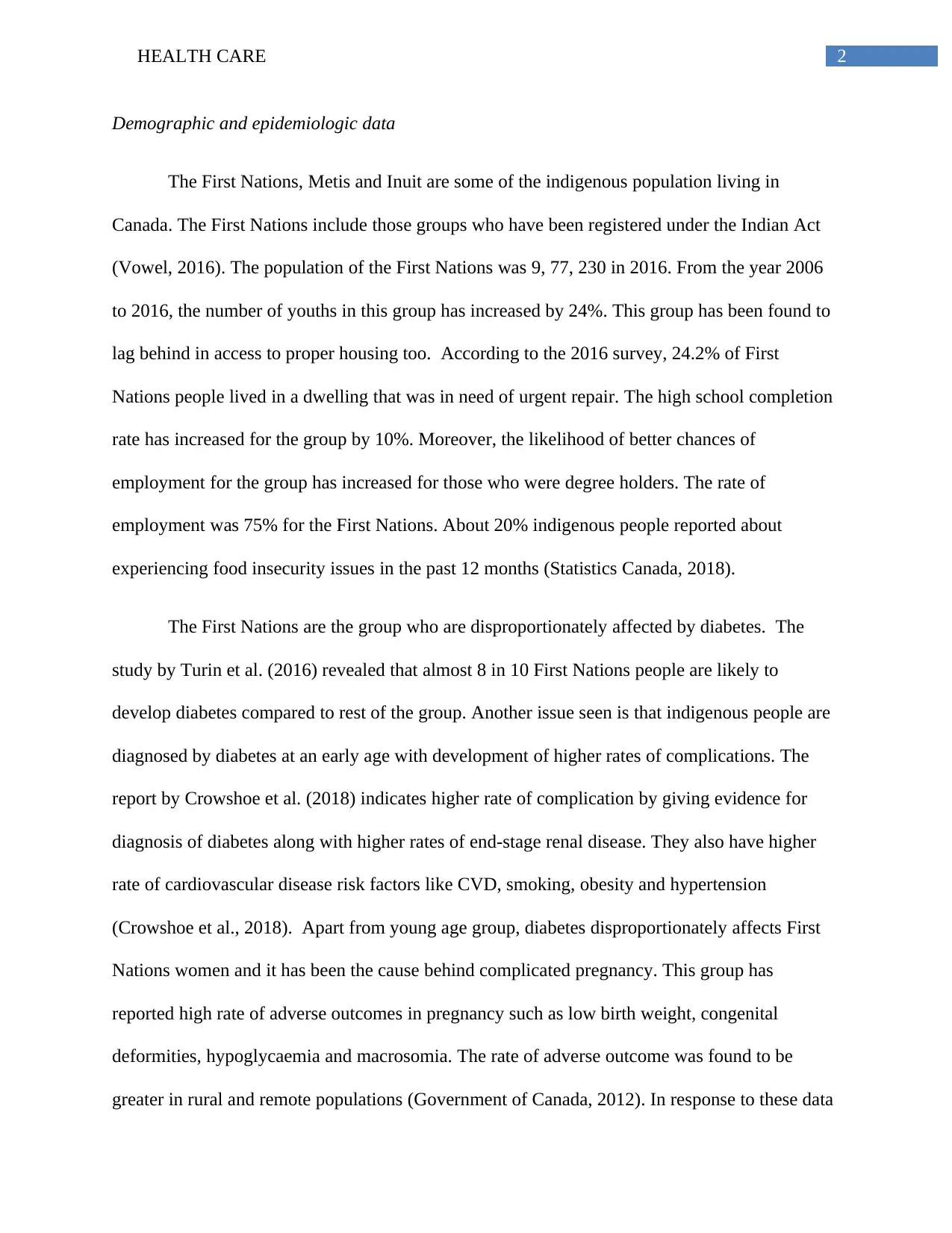
2HEALTH CARE
Demographic and epidemiologic data
The First Nations, Metis and Inuit are some of the indigenous population living in
Canada. The First Nations include those groups who have been registered under the Indian Act
(Vowel, 2016). The population of the First Nations was 9, 77, 230 in 2016. From the year 2006
to 2016, the number of youths in this group has increased by 24%. This group has been found to
lag behind in access to proper housing too. According to the 2016 survey, 24.2% of First
Nations people lived in a dwelling that was in need of urgent repair. The high school completion
rate has increased for the group by 10%. Moreover, the likelihood of better chances of
employment for the group has increased for those who were degree holders. The rate of
employment was 75% for the First Nations. About 20% indigenous people reported about
experiencing food insecurity issues in the past 12 months (Statistics Canada, 2018).
The First Nations are the group who are disproportionately affected by diabetes. The
study by Turin et al. (2016) revealed that almost 8 in 10 First Nations people are likely to
develop diabetes compared to rest of the group. Another issue seen is that indigenous people are
diagnosed by diabetes at an early age with development of higher rates of complications. The
report by Crowshoe et al. (2018) indicates higher rate of complication by giving evidence for
diagnosis of diabetes along with higher rates of end-stage renal disease. They also have higher
rate of cardiovascular disease risk factors like CVD, smoking, obesity and hypertension
(Crowshoe et al., 2018). Apart from young age group, diabetes disproportionately affects First
Nations women and it has been the cause behind complicated pregnancy. This group has
reported high rate of adverse outcomes in pregnancy such as low birth weight, congenital
deformities, hypoglycaemia and macrosomia. The rate of adverse outcome was found to be
greater in rural and remote populations (Government of Canada, 2012). In response to these data
Demographic and epidemiologic data
The First Nations, Metis and Inuit are some of the indigenous population living in
Canada. The First Nations include those groups who have been registered under the Indian Act
(Vowel, 2016). The population of the First Nations was 9, 77, 230 in 2016. From the year 2006
to 2016, the number of youths in this group has increased by 24%. This group has been found to
lag behind in access to proper housing too. According to the 2016 survey, 24.2% of First
Nations people lived in a dwelling that was in need of urgent repair. The high school completion
rate has increased for the group by 10%. Moreover, the likelihood of better chances of
employment for the group has increased for those who were degree holders. The rate of
employment was 75% for the First Nations. About 20% indigenous people reported about
experiencing food insecurity issues in the past 12 months (Statistics Canada, 2018).
The First Nations are the group who are disproportionately affected by diabetes. The
study by Turin et al. (2016) revealed that almost 8 in 10 First Nations people are likely to
develop diabetes compared to rest of the group. Another issue seen is that indigenous people are
diagnosed by diabetes at an early age with development of higher rates of complications. The
report by Crowshoe et al. (2018) indicates higher rate of complication by giving evidence for
diagnosis of diabetes along with higher rates of end-stage renal disease. They also have higher
rate of cardiovascular disease risk factors like CVD, smoking, obesity and hypertension
(Crowshoe et al., 2018). Apart from young age group, diabetes disproportionately affects First
Nations women and it has been the cause behind complicated pregnancy. This group has
reported high rate of adverse outcomes in pregnancy such as low birth weight, congenital
deformities, hypoglycaemia and macrosomia. The rate of adverse outcome was found to be
greater in rural and remote populations (Government of Canada, 2012). In response to these data
⊘ This is a preview!⊘
Do you want full access?
Subscribe today to unlock all pages.

Trusted by 1+ million students worldwide
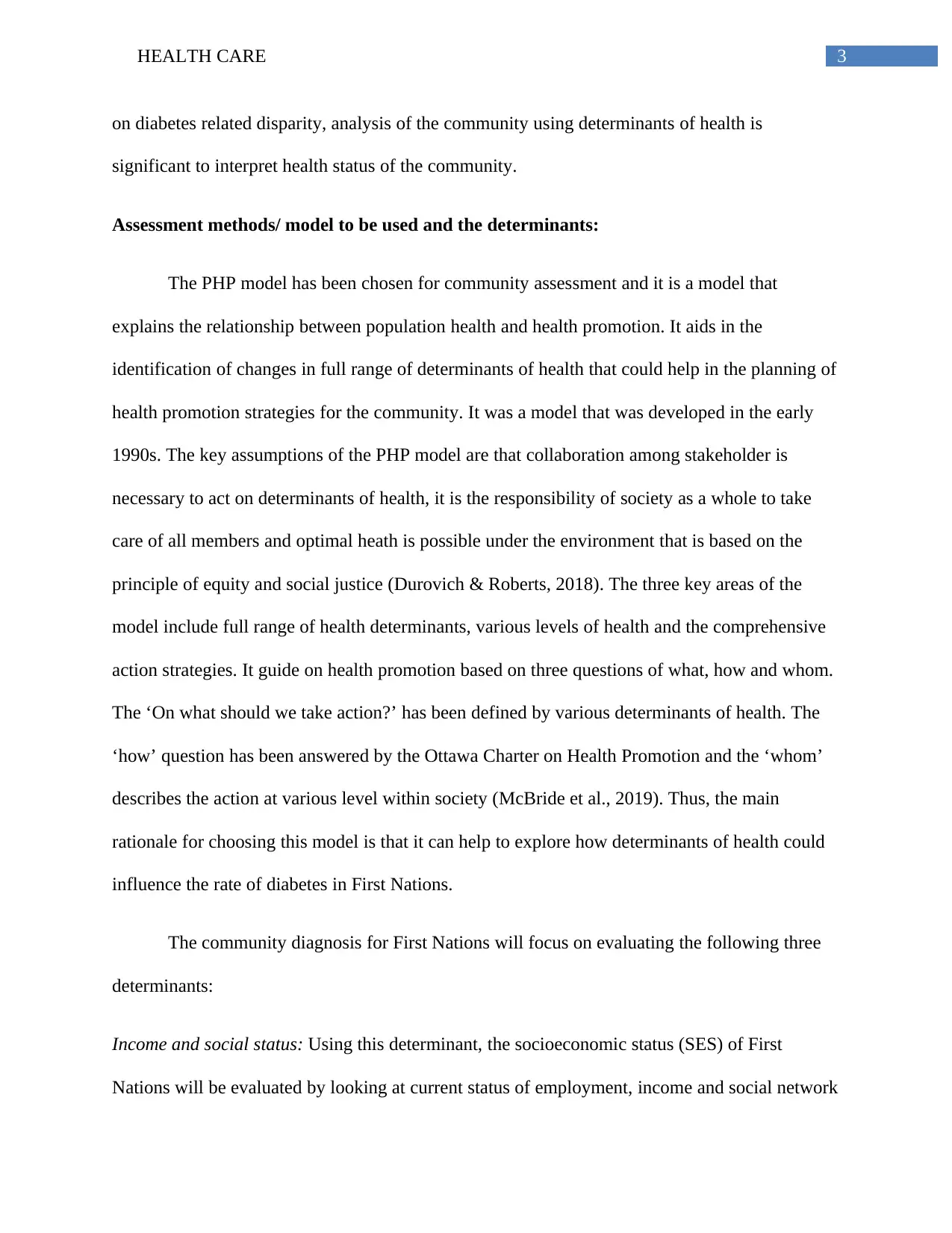
3HEALTH CARE
on diabetes related disparity, analysis of the community using determinants of health is
significant to interpret health status of the community.
Assessment methods/ model to be used and the determinants:
The PHP model has been chosen for community assessment and it is a model that
explains the relationship between population health and health promotion. It aids in the
identification of changes in full range of determinants of health that could help in the planning of
health promotion strategies for the community. It was a model that was developed in the early
1990s. The key assumptions of the PHP model are that collaboration among stakeholder is
necessary to act on determinants of health, it is the responsibility of society as a whole to take
care of all members and optimal heath is possible under the environment that is based on the
principle of equity and social justice (Durovich & Roberts, 2018). The three key areas of the
model include full range of health determinants, various levels of health and the comprehensive
action strategies. It guide on health promotion based on three questions of what, how and whom.
The ‘On what should we take action?’ has been defined by various determinants of health. The
‘how’ question has been answered by the Ottawa Charter on Health Promotion and the ‘whom’
describes the action at various level within society (McBride et al., 2019). Thus, the main
rationale for choosing this model is that it can help to explore how determinants of health could
influence the rate of diabetes in First Nations.
The community diagnosis for First Nations will focus on evaluating the following three
determinants:
Income and social status: Using this determinant, the socioeconomic status (SES) of First
Nations will be evaluated by looking at current status of employment, income and social network
on diabetes related disparity, analysis of the community using determinants of health is
significant to interpret health status of the community.
Assessment methods/ model to be used and the determinants:
The PHP model has been chosen for community assessment and it is a model that
explains the relationship between population health and health promotion. It aids in the
identification of changes in full range of determinants of health that could help in the planning of
health promotion strategies for the community. It was a model that was developed in the early
1990s. The key assumptions of the PHP model are that collaboration among stakeholder is
necessary to act on determinants of health, it is the responsibility of society as a whole to take
care of all members and optimal heath is possible under the environment that is based on the
principle of equity and social justice (Durovich & Roberts, 2018). The three key areas of the
model include full range of health determinants, various levels of health and the comprehensive
action strategies. It guide on health promotion based on three questions of what, how and whom.
The ‘On what should we take action?’ has been defined by various determinants of health. The
‘how’ question has been answered by the Ottawa Charter on Health Promotion and the ‘whom’
describes the action at various level within society (McBride et al., 2019). Thus, the main
rationale for choosing this model is that it can help to explore how determinants of health could
influence the rate of diabetes in First Nations.
The community diagnosis for First Nations will focus on evaluating the following three
determinants:
Income and social status: Using this determinant, the socioeconomic status (SES) of First
Nations will be evaluated by looking at current status of employment, income and social network
Paraphrase This Document
Need a fresh take? Get an instant paraphrase of this document with our AI Paraphraser
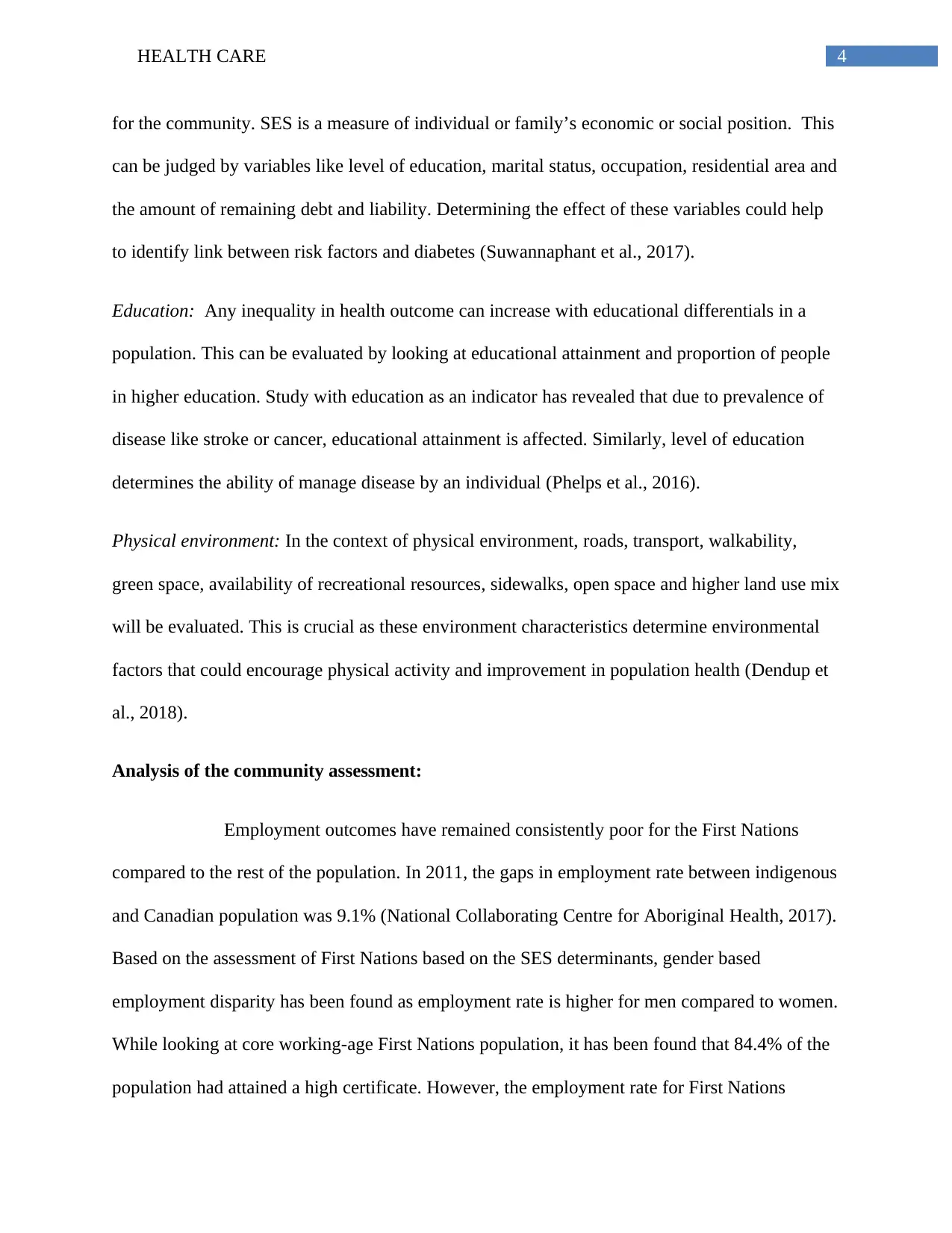
4HEALTH CARE
for the community. SES is a measure of individual or family’s economic or social position. This
can be judged by variables like level of education, marital status, occupation, residential area and
the amount of remaining debt and liability. Determining the effect of these variables could help
to identify link between risk factors and diabetes (Suwannaphant et al., 2017).
Education: Any inequality in health outcome can increase with educational differentials in a
population. This can be evaluated by looking at educational attainment and proportion of people
in higher education. Study with education as an indicator has revealed that due to prevalence of
disease like stroke or cancer, educational attainment is affected. Similarly, level of education
determines the ability of manage disease by an individual (Phelps et al., 2016).
Physical environment: In the context of physical environment, roads, transport, walkability,
green space, availability of recreational resources, sidewalks, open space and higher land use mix
will be evaluated. This is crucial as these environment characteristics determine environmental
factors that could encourage physical activity and improvement in population health (Dendup et
al., 2018).
Analysis of the community assessment:
Employment outcomes have remained consistently poor for the First Nations
compared to the rest of the population. In 2011, the gaps in employment rate between indigenous
and Canadian population was 9.1% (National Collaborating Centre for Aboriginal Health, 2017).
Based on the assessment of First Nations based on the SES determinants, gender based
employment disparity has been found as employment rate is higher for men compared to women.
While looking at core working-age First Nations population, it has been found that 84.4% of the
population had attained a high certificate. However, the employment rate for First Nations
for the community. SES is a measure of individual or family’s economic or social position. This
can be judged by variables like level of education, marital status, occupation, residential area and
the amount of remaining debt and liability. Determining the effect of these variables could help
to identify link between risk factors and diabetes (Suwannaphant et al., 2017).
Education: Any inequality in health outcome can increase with educational differentials in a
population. This can be evaluated by looking at educational attainment and proportion of people
in higher education. Study with education as an indicator has revealed that due to prevalence of
disease like stroke or cancer, educational attainment is affected. Similarly, level of education
determines the ability of manage disease by an individual (Phelps et al., 2016).
Physical environment: In the context of physical environment, roads, transport, walkability,
green space, availability of recreational resources, sidewalks, open space and higher land use mix
will be evaluated. This is crucial as these environment characteristics determine environmental
factors that could encourage physical activity and improvement in population health (Dendup et
al., 2018).
Analysis of the community assessment:
Employment outcomes have remained consistently poor for the First Nations
compared to the rest of the population. In 2011, the gaps in employment rate between indigenous
and Canadian population was 9.1% (National Collaborating Centre for Aboriginal Health, 2017).
Based on the assessment of First Nations based on the SES determinants, gender based
employment disparity has been found as employment rate is higher for men compared to women.
While looking at core working-age First Nations population, it has been found that 84.4% of the
population had attained a high certificate. However, the employment rate for First Nations
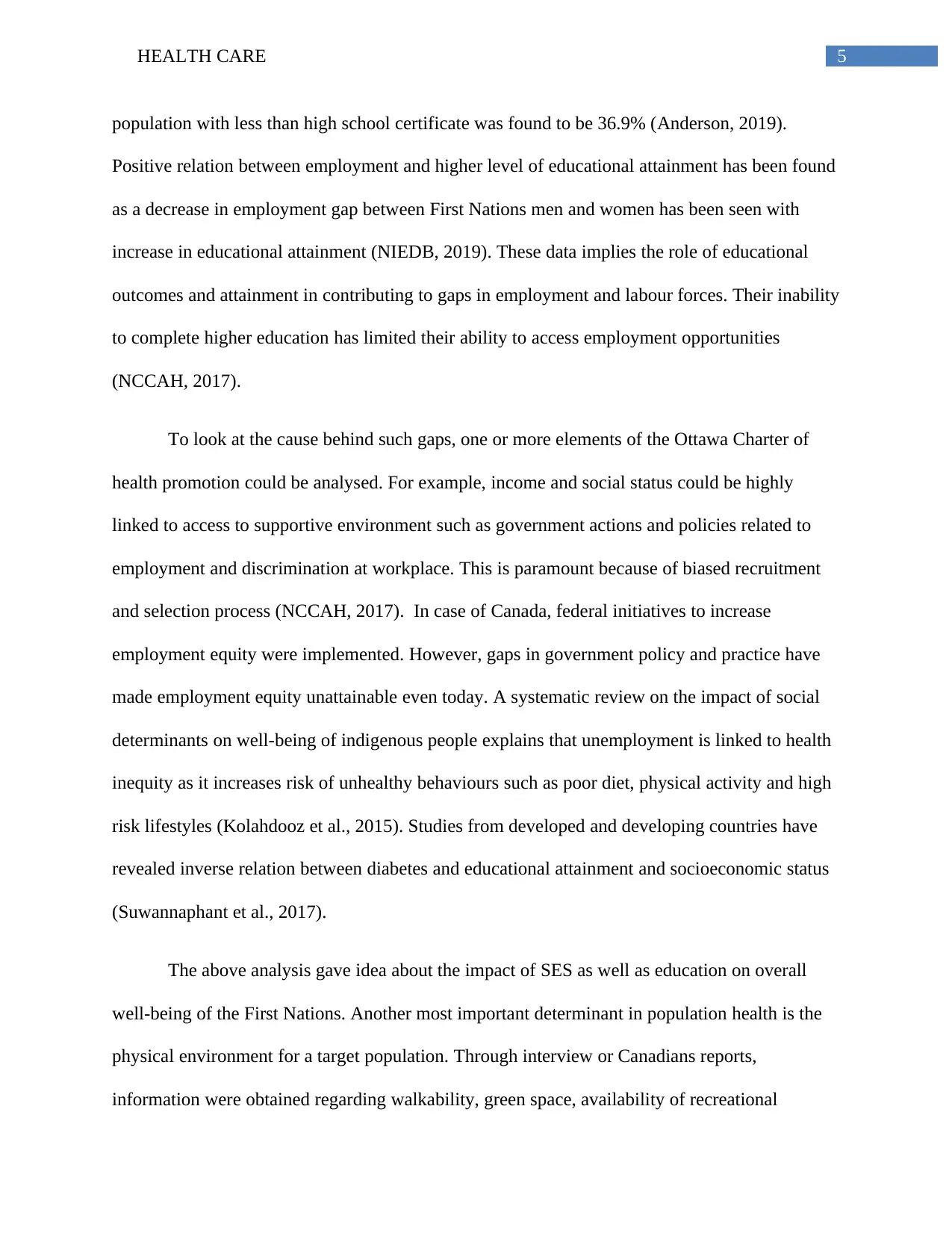
5HEALTH CARE
population with less than high school certificate was found to be 36.9% (Anderson, 2019).
Positive relation between employment and higher level of educational attainment has been found
as a decrease in employment gap between First Nations men and women has been seen with
increase in educational attainment (NIEDB, 2019). These data implies the role of educational
outcomes and attainment in contributing to gaps in employment and labour forces. Their inability
to complete higher education has limited their ability to access employment opportunities
(NCCAH, 2017).
To look at the cause behind such gaps, one or more elements of the Ottawa Charter of
health promotion could be analysed. For example, income and social status could be highly
linked to access to supportive environment such as government actions and policies related to
employment and discrimination at workplace. This is paramount because of biased recruitment
and selection process (NCCAH, 2017). In case of Canada, federal initiatives to increase
employment equity were implemented. However, gaps in government policy and practice have
made employment equity unattainable even today. A systematic review on the impact of social
determinants on well-being of indigenous people explains that unemployment is linked to health
inequity as it increases risk of unhealthy behaviours such as poor diet, physical activity and high
risk lifestyles (Kolahdooz et al., 2015). Studies from developed and developing countries have
revealed inverse relation between diabetes and educational attainment and socioeconomic status
(Suwannaphant et al., 2017).
The above analysis gave idea about the impact of SES as well as education on overall
well-being of the First Nations. Another most important determinant in population health is the
physical environment for a target population. Through interview or Canadians reports,
information were obtained regarding walkability, green space, availability of recreational
population with less than high school certificate was found to be 36.9% (Anderson, 2019).
Positive relation between employment and higher level of educational attainment has been found
as a decrease in employment gap between First Nations men and women has been seen with
increase in educational attainment (NIEDB, 2019). These data implies the role of educational
outcomes and attainment in contributing to gaps in employment and labour forces. Their inability
to complete higher education has limited their ability to access employment opportunities
(NCCAH, 2017).
To look at the cause behind such gaps, one or more elements of the Ottawa Charter of
health promotion could be analysed. For example, income and social status could be highly
linked to access to supportive environment such as government actions and policies related to
employment and discrimination at workplace. This is paramount because of biased recruitment
and selection process (NCCAH, 2017). In case of Canada, federal initiatives to increase
employment equity were implemented. However, gaps in government policy and practice have
made employment equity unattainable even today. A systematic review on the impact of social
determinants on well-being of indigenous people explains that unemployment is linked to health
inequity as it increases risk of unhealthy behaviours such as poor diet, physical activity and high
risk lifestyles (Kolahdooz et al., 2015). Studies from developed and developing countries have
revealed inverse relation between diabetes and educational attainment and socioeconomic status
(Suwannaphant et al., 2017).
The above analysis gave idea about the impact of SES as well as education on overall
well-being of the First Nations. Another most important determinant in population health is the
physical environment for a target population. Through interview or Canadians reports,
information were obtained regarding walkability, green space, availability of recreational
⊘ This is a preview!⊘
Do you want full access?
Subscribe today to unlock all pages.

Trusted by 1+ million students worldwide
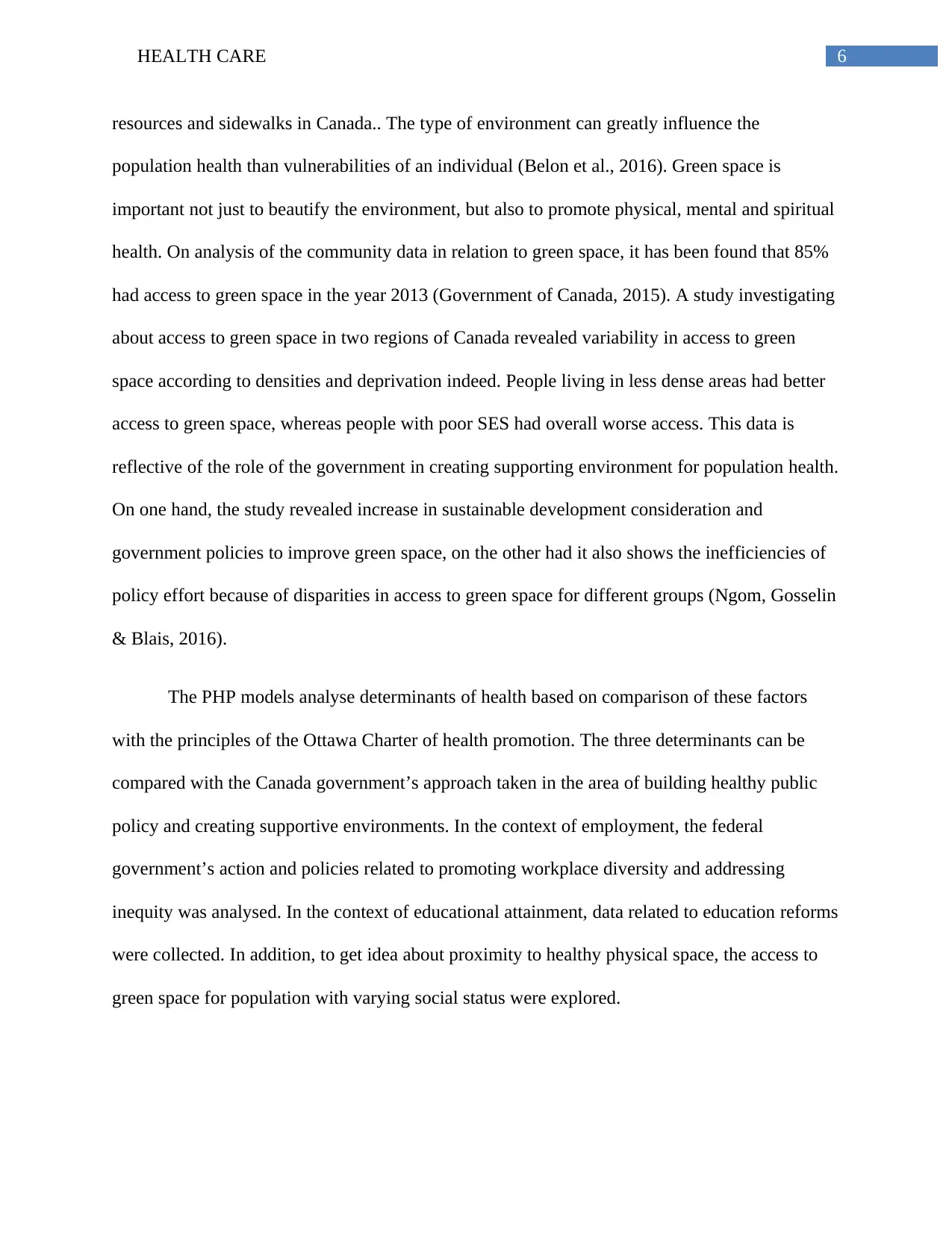
6HEALTH CARE
resources and sidewalks in Canada.. The type of environment can greatly influence the
population health than vulnerabilities of an individual (Belon et al., 2016). Green space is
important not just to beautify the environment, but also to promote physical, mental and spiritual
health. On analysis of the community data in relation to green space, it has been found that 85%
had access to green space in the year 2013 (Government of Canada, 2015). A study investigating
about access to green space in two regions of Canada revealed variability in access to green
space according to densities and deprivation indeed. People living in less dense areas had better
access to green space, whereas people with poor SES had overall worse access. This data is
reflective of the role of the government in creating supporting environment for population health.
On one hand, the study revealed increase in sustainable development consideration and
government policies to improve green space, on the other had it also shows the inefficiencies of
policy effort because of disparities in access to green space for different groups (Ngom, Gosselin
& Blais, 2016).
The PHP models analyse determinants of health based on comparison of these factors
with the principles of the Ottawa Charter of health promotion. The three determinants can be
compared with the Canada government’s approach taken in the area of building healthy public
policy and creating supportive environments. In the context of employment, the federal
government’s action and policies related to promoting workplace diversity and addressing
inequity was analysed. In the context of educational attainment, data related to education reforms
were collected. In addition, to get idea about proximity to healthy physical space, the access to
green space for population with varying social status were explored.
resources and sidewalks in Canada.. The type of environment can greatly influence the
population health than vulnerabilities of an individual (Belon et al., 2016). Green space is
important not just to beautify the environment, but also to promote physical, mental and spiritual
health. On analysis of the community data in relation to green space, it has been found that 85%
had access to green space in the year 2013 (Government of Canada, 2015). A study investigating
about access to green space in two regions of Canada revealed variability in access to green
space according to densities and deprivation indeed. People living in less dense areas had better
access to green space, whereas people with poor SES had overall worse access. This data is
reflective of the role of the government in creating supporting environment for population health.
On one hand, the study revealed increase in sustainable development consideration and
government policies to improve green space, on the other had it also shows the inefficiencies of
policy effort because of disparities in access to green space for different groups (Ngom, Gosselin
& Blais, 2016).
The PHP models analyse determinants of health based on comparison of these factors
with the principles of the Ottawa Charter of health promotion. The three determinants can be
compared with the Canada government’s approach taken in the area of building healthy public
policy and creating supportive environments. In the context of employment, the federal
government’s action and policies related to promoting workplace diversity and addressing
inequity was analysed. In the context of educational attainment, data related to education reforms
were collected. In addition, to get idea about proximity to healthy physical space, the access to
green space for population with varying social status were explored.
Paraphrase This Document
Need a fresh take? Get an instant paraphrase of this document with our AI Paraphraser
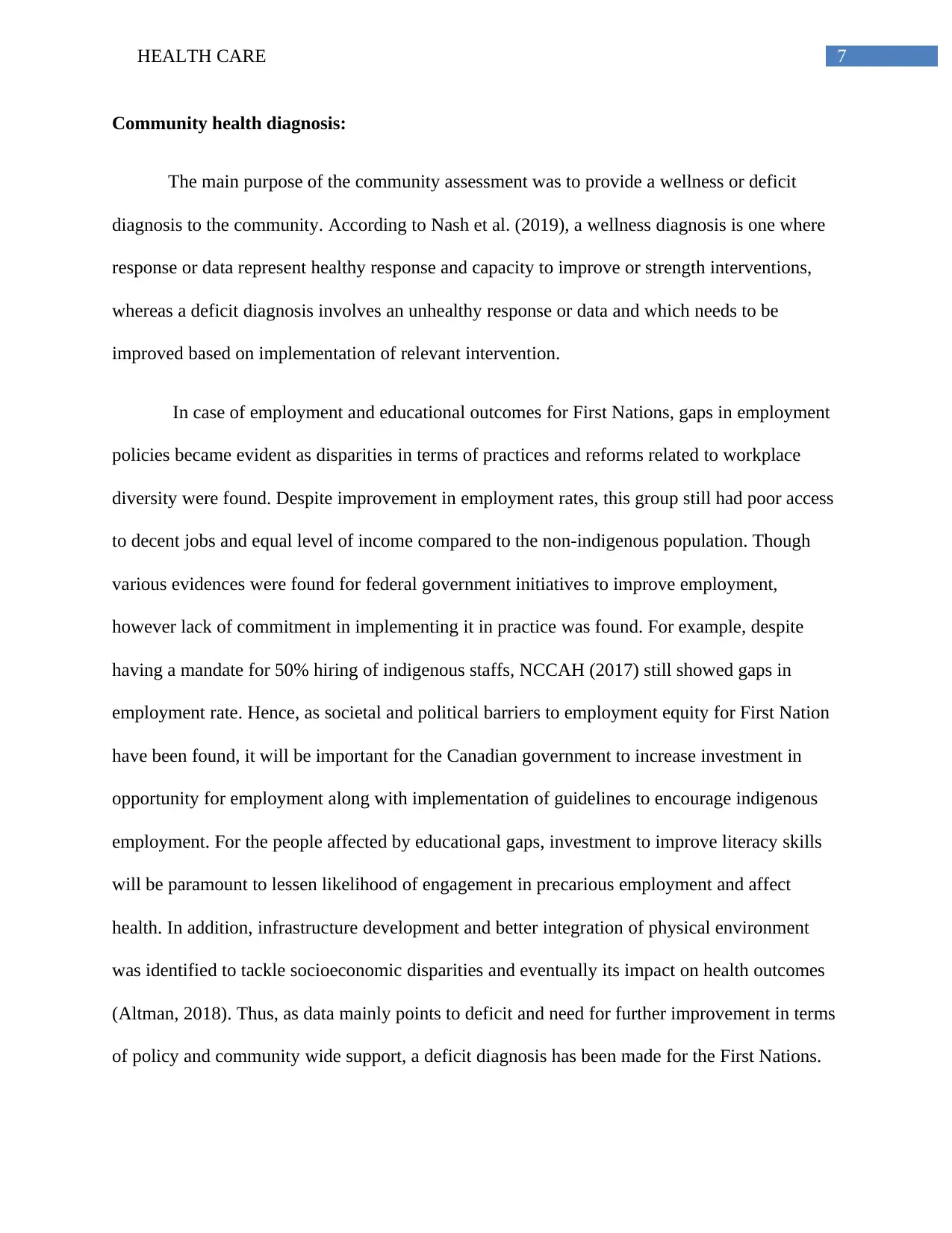
7HEALTH CARE
Community health diagnosis:
The main purpose of the community assessment was to provide a wellness or deficit
diagnosis to the community. According to Nash et al. (2019), a wellness diagnosis is one where
response or data represent healthy response and capacity to improve or strength interventions,
whereas a deficit diagnosis involves an unhealthy response or data and which needs to be
improved based on implementation of relevant intervention.
In case of employment and educational outcomes for First Nations, gaps in employment
policies became evident as disparities in terms of practices and reforms related to workplace
diversity were found. Despite improvement in employment rates, this group still had poor access
to decent jobs and equal level of income compared to the non-indigenous population. Though
various evidences were found for federal government initiatives to improve employment,
however lack of commitment in implementing it in practice was found. For example, despite
having a mandate for 50% hiring of indigenous staffs, NCCAH (2017) still showed gaps in
employment rate. Hence, as societal and political barriers to employment equity for First Nation
have been found, it will be important for the Canadian government to increase investment in
opportunity for employment along with implementation of guidelines to encourage indigenous
employment. For the people affected by educational gaps, investment to improve literacy skills
will be paramount to lessen likelihood of engagement in precarious employment and affect
health. In addition, infrastructure development and better integration of physical environment
was identified to tackle socioeconomic disparities and eventually its impact on health outcomes
(Altman, 2018). Thus, as data mainly points to deficit and need for further improvement in terms
of policy and community wide support, a deficit diagnosis has been made for the First Nations.
Community health diagnosis:
The main purpose of the community assessment was to provide a wellness or deficit
diagnosis to the community. According to Nash et al. (2019), a wellness diagnosis is one where
response or data represent healthy response and capacity to improve or strength interventions,
whereas a deficit diagnosis involves an unhealthy response or data and which needs to be
improved based on implementation of relevant intervention.
In case of employment and educational outcomes for First Nations, gaps in employment
policies became evident as disparities in terms of practices and reforms related to workplace
diversity were found. Despite improvement in employment rates, this group still had poor access
to decent jobs and equal level of income compared to the non-indigenous population. Though
various evidences were found for federal government initiatives to improve employment,
however lack of commitment in implementing it in practice was found. For example, despite
having a mandate for 50% hiring of indigenous staffs, NCCAH (2017) still showed gaps in
employment rate. Hence, as societal and political barriers to employment equity for First Nation
have been found, it will be important for the Canadian government to increase investment in
opportunity for employment along with implementation of guidelines to encourage indigenous
employment. For the people affected by educational gaps, investment to improve literacy skills
will be paramount to lessen likelihood of engagement in precarious employment and affect
health. In addition, infrastructure development and better integration of physical environment
was identified to tackle socioeconomic disparities and eventually its impact on health outcomes
(Altman, 2018). Thus, as data mainly points to deficit and need for further improvement in terms
of policy and community wide support, a deficit diagnosis has been made for the First Nations.
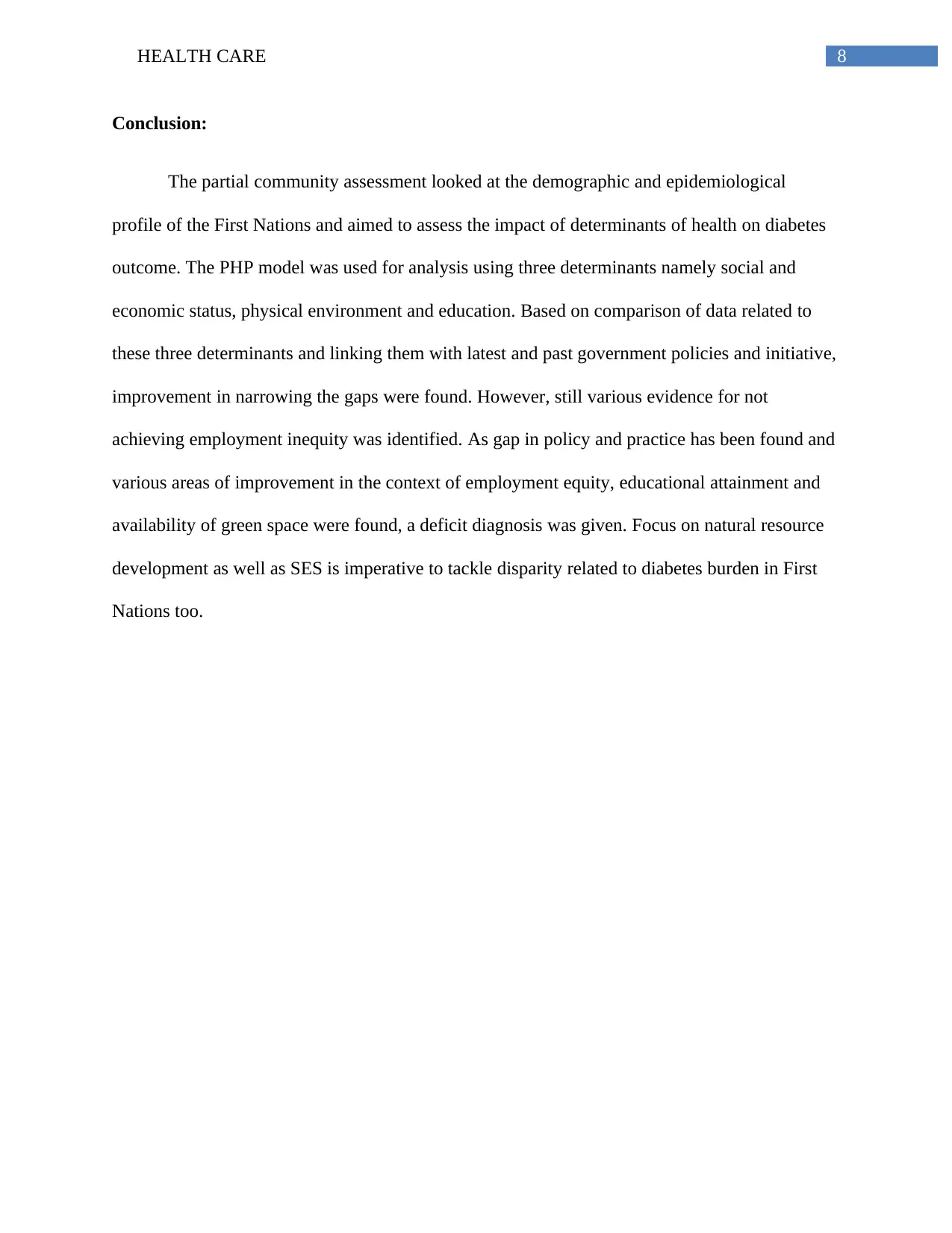
8HEALTH CARE
Conclusion:
The partial community assessment looked at the demographic and epidemiological
profile of the First Nations and aimed to assess the impact of determinants of health on diabetes
outcome. The PHP model was used for analysis using three determinants namely social and
economic status, physical environment and education. Based on comparison of data related to
these three determinants and linking them with latest and past government policies and initiative,
improvement in narrowing the gaps were found. However, still various evidence for not
achieving employment inequity was identified. As gap in policy and practice has been found and
various areas of improvement in the context of employment equity, educational attainment and
availability of green space were found, a deficit diagnosis was given. Focus on natural resource
development as well as SES is imperative to tackle disparity related to diabetes burden in First
Nations too.
Conclusion:
The partial community assessment looked at the demographic and epidemiological
profile of the First Nations and aimed to assess the impact of determinants of health on diabetes
outcome. The PHP model was used for analysis using three determinants namely social and
economic status, physical environment and education. Based on comparison of data related to
these three determinants and linking them with latest and past government policies and initiative,
improvement in narrowing the gaps were found. However, still various evidence for not
achieving employment inequity was identified. As gap in policy and practice has been found and
various areas of improvement in the context of employment equity, educational attainment and
availability of green space were found, a deficit diagnosis was given. Focus on natural resource
development as well as SES is imperative to tackle disparity related to diabetes burden in First
Nations too.
⊘ This is a preview!⊘
Do you want full access?
Subscribe today to unlock all pages.

Trusted by 1+ million students worldwide
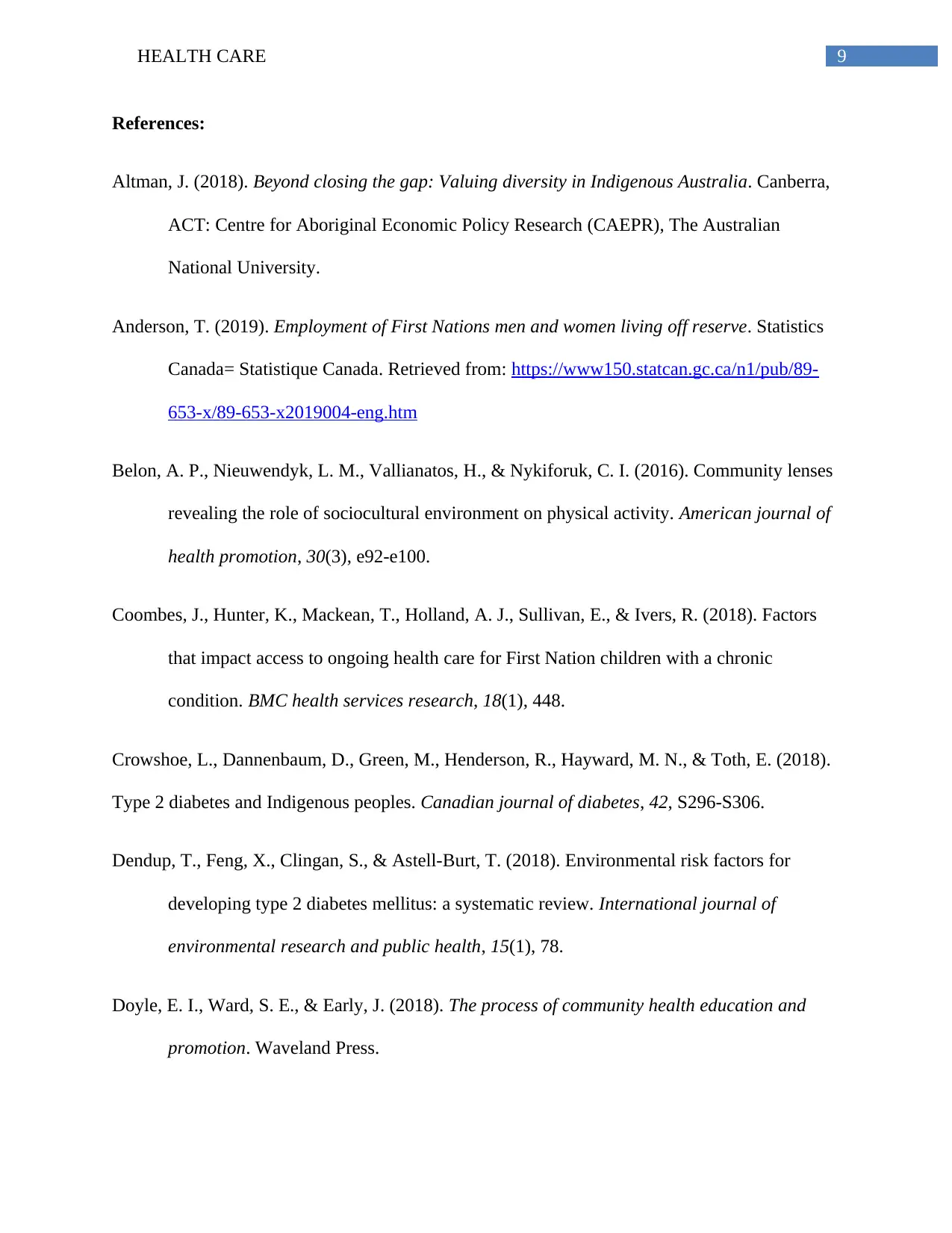
9HEALTH CARE
References:
Altman, J. (2018). Beyond closing the gap: Valuing diversity in Indigenous Australia. Canberra,
ACT: Centre for Aboriginal Economic Policy Research (CAEPR), The Australian
National University.
Anderson, T. (2019). Employment of First Nations men and women living off reserve. Statistics
Canada= Statistique Canada. Retrieved from: https://www150.statcan.gc.ca/n1/pub/89-
653-x/89-653-x2019004-eng.htm
Belon, A. P., Nieuwendyk, L. M., Vallianatos, H., & Nykiforuk, C. I. (2016). Community lenses
revealing the role of sociocultural environment on physical activity. American journal of
health promotion, 30(3), e92-e100.
Coombes, J., Hunter, K., Mackean, T., Holland, A. J., Sullivan, E., & Ivers, R. (2018). Factors
that impact access to ongoing health care for First Nation children with a chronic
condition. BMC health services research, 18(1), 448.
Crowshoe, L., Dannenbaum, D., Green, M., Henderson, R., Hayward, M. N., & Toth, E. (2018).
Type 2 diabetes and Indigenous peoples. Canadian journal of diabetes, 42, S296-S306.
Dendup, T., Feng, X., Clingan, S., & Astell-Burt, T. (2018). Environmental risk factors for
developing type 2 diabetes mellitus: a systematic review. International journal of
environmental research and public health, 15(1), 78.
Doyle, E. I., Ward, S. E., & Early, J. (2018). The process of community health education and
promotion. Waveland Press.
References:
Altman, J. (2018). Beyond closing the gap: Valuing diversity in Indigenous Australia. Canberra,
ACT: Centre for Aboriginal Economic Policy Research (CAEPR), The Australian
National University.
Anderson, T. (2019). Employment of First Nations men and women living off reserve. Statistics
Canada= Statistique Canada. Retrieved from: https://www150.statcan.gc.ca/n1/pub/89-
653-x/89-653-x2019004-eng.htm
Belon, A. P., Nieuwendyk, L. M., Vallianatos, H., & Nykiforuk, C. I. (2016). Community lenses
revealing the role of sociocultural environment on physical activity. American journal of
health promotion, 30(3), e92-e100.
Coombes, J., Hunter, K., Mackean, T., Holland, A. J., Sullivan, E., & Ivers, R. (2018). Factors
that impact access to ongoing health care for First Nation children with a chronic
condition. BMC health services research, 18(1), 448.
Crowshoe, L., Dannenbaum, D., Green, M., Henderson, R., Hayward, M. N., & Toth, E. (2018).
Type 2 diabetes and Indigenous peoples. Canadian journal of diabetes, 42, S296-S306.
Dendup, T., Feng, X., Clingan, S., & Astell-Burt, T. (2018). Environmental risk factors for
developing type 2 diabetes mellitus: a systematic review. International journal of
environmental research and public health, 15(1), 78.
Doyle, E. I., Ward, S. E., & Early, J. (2018). The process of community health education and
promotion. Waveland Press.
Paraphrase This Document
Need a fresh take? Get an instant paraphrase of this document with our AI Paraphraser
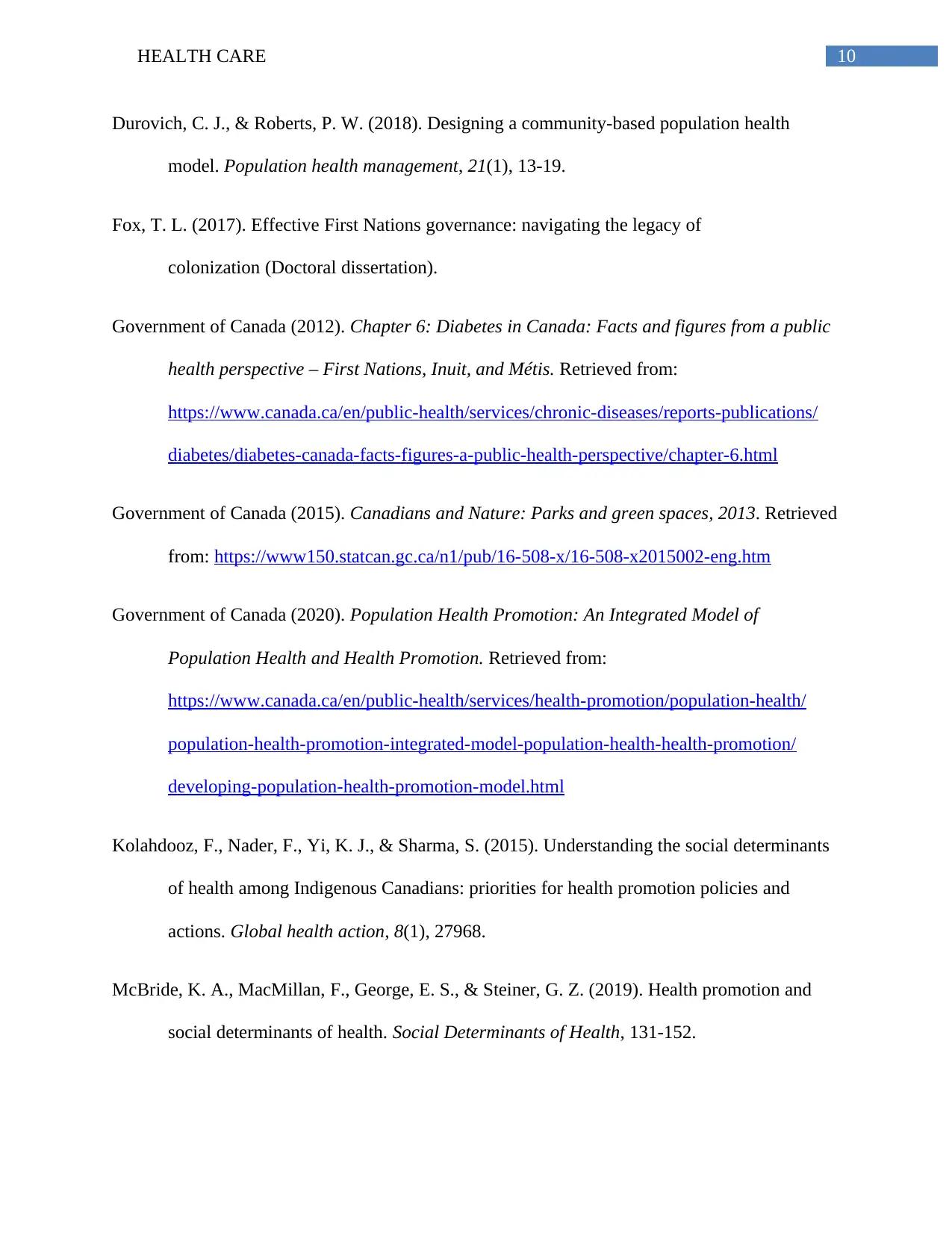
10HEALTH CARE
Durovich, C. J., & Roberts, P. W. (2018). Designing a community-based population health
model. Population health management, 21(1), 13-19.
Fox, T. L. (2017). Effective First Nations governance: navigating the legacy of
colonization (Doctoral dissertation).
Government of Canada (2012). Chapter 6: Diabetes in Canada: Facts and figures from a public
health perspective – First Nations, Inuit, and Métis. Retrieved from:
https://www.canada.ca/en/public-health/services/chronic-diseases/reports-publications/
diabetes/diabetes-canada-facts-figures-a-public-health-perspective/chapter-6.html
Government of Canada (2015). Canadians and Nature: Parks and green spaces, 2013. Retrieved
from: https://www150.statcan.gc.ca/n1/pub/16-508-x/16-508-x2015002-eng.htm
Government of Canada (2020). Population Health Promotion: An Integrated Model of
Population Health and Health Promotion. Retrieved from:
https://www.canada.ca/en/public-health/services/health-promotion/population-health/
population-health-promotion-integrated-model-population-health-health-promotion/
developing-population-health-promotion-model.html
Kolahdooz, F., Nader, F., Yi, K. J., & Sharma, S. (2015). Understanding the social determinants
of health among Indigenous Canadians: priorities for health promotion policies and
actions. Global health action, 8(1), 27968.
McBride, K. A., MacMillan, F., George, E. S., & Steiner, G. Z. (2019). Health promotion and
social determinants of health. Social Determinants of Health, 131-152.
Durovich, C. J., & Roberts, P. W. (2018). Designing a community-based population health
model. Population health management, 21(1), 13-19.
Fox, T. L. (2017). Effective First Nations governance: navigating the legacy of
colonization (Doctoral dissertation).
Government of Canada (2012). Chapter 6: Diabetes in Canada: Facts and figures from a public
health perspective – First Nations, Inuit, and Métis. Retrieved from:
https://www.canada.ca/en/public-health/services/chronic-diseases/reports-publications/
diabetes/diabetes-canada-facts-figures-a-public-health-perspective/chapter-6.html
Government of Canada (2015). Canadians and Nature: Parks and green spaces, 2013. Retrieved
from: https://www150.statcan.gc.ca/n1/pub/16-508-x/16-508-x2015002-eng.htm
Government of Canada (2020). Population Health Promotion: An Integrated Model of
Population Health and Health Promotion. Retrieved from:
https://www.canada.ca/en/public-health/services/health-promotion/population-health/
population-health-promotion-integrated-model-population-health-health-promotion/
developing-population-health-promotion-model.html
Kolahdooz, F., Nader, F., Yi, K. J., & Sharma, S. (2015). Understanding the social determinants
of health among Indigenous Canadians: priorities for health promotion policies and
actions. Global health action, 8(1), 27968.
McBride, K. A., MacMillan, F., George, E. S., & Steiner, G. Z. (2019). Health promotion and
social determinants of health. Social Determinants of Health, 131-152.
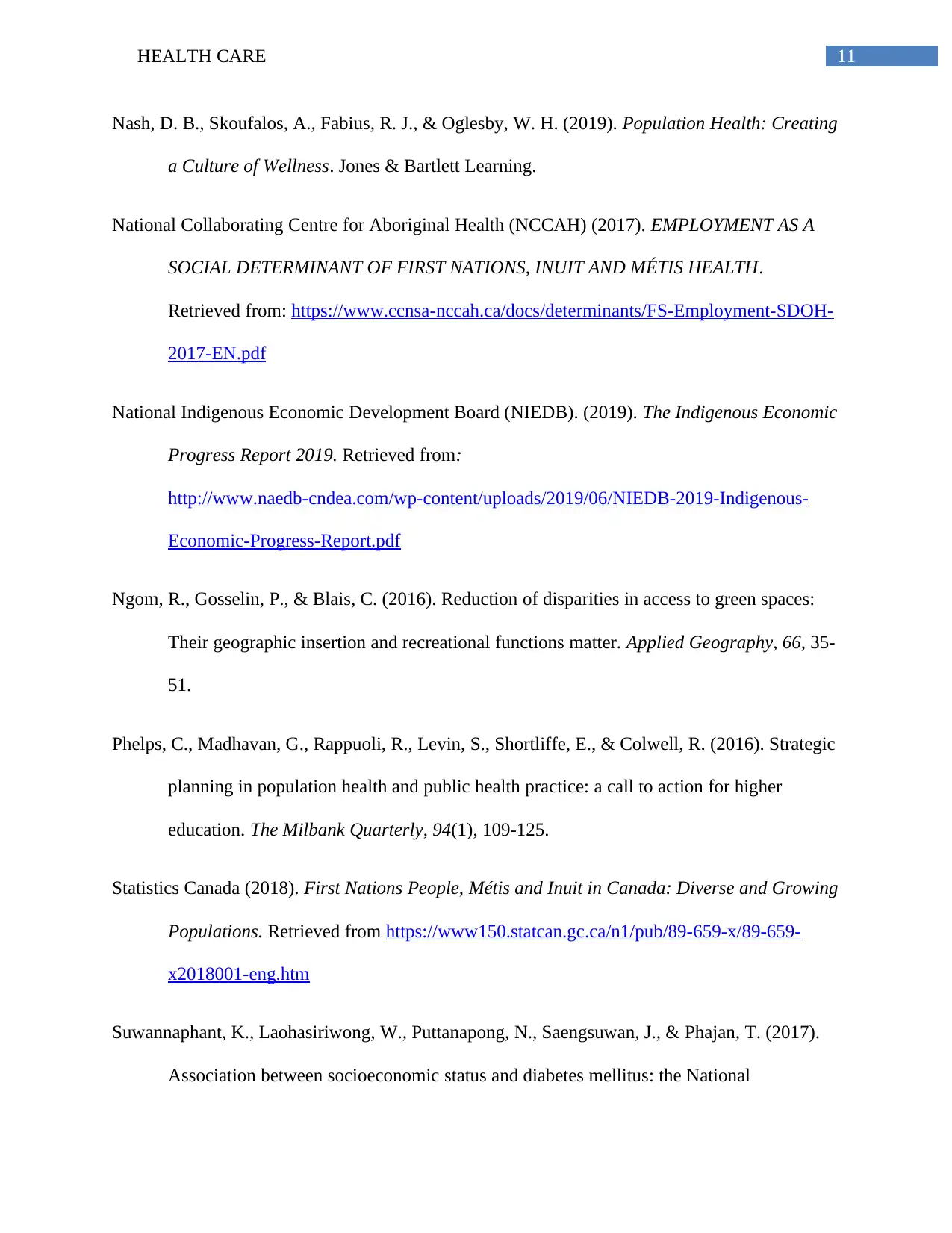
11HEALTH CARE
Nash, D. B., Skoufalos, A., Fabius, R. J., & Oglesby, W. H. (2019). Population Health: Creating
a Culture of Wellness. Jones & Bartlett Learning.
National Collaborating Centre for Aboriginal Health (NCCAH) (2017). EMPLOYMENT AS A
SOCIAL DETERMINANT OF FIRST NATIONS, INUIT AND MÉTIS HEALTH.
Retrieved from: https://www.ccnsa-nccah.ca/docs/determinants/FS-Employment-SDOH-
2017-EN.pdf
National Indigenous Economic Development Board (NIEDB). (2019). The Indigenous Economic
Progress Report 2019. Retrieved from:
http://www.naedb-cndea.com/wp-content/uploads/2019/06/NIEDB-2019-Indigenous-
Economic-Progress-Report.pdf
Ngom, R., Gosselin, P., & Blais, C. (2016). Reduction of disparities in access to green spaces:
Their geographic insertion and recreational functions matter. Applied Geography, 66, 35-
51.
Phelps, C., Madhavan, G., Rappuoli, R., Levin, S., Shortliffe, E., & Colwell, R. (2016). Strategic
planning in population health and public health practice: a call to action for higher
education. The Milbank Quarterly, 94(1), 109-125.
Statistics Canada (2018). First Nations People, Métis and Inuit in Canada: Diverse and Growing
Populations. Retrieved from https://www150.statcan.gc.ca/n1/pub/89-659-x/89-659-
x2018001-eng.htm
Suwannaphant, K., Laohasiriwong, W., Puttanapong, N., Saengsuwan, J., & Phajan, T. (2017).
Association between socioeconomic status and diabetes mellitus: the National
Nash, D. B., Skoufalos, A., Fabius, R. J., & Oglesby, W. H. (2019). Population Health: Creating
a Culture of Wellness. Jones & Bartlett Learning.
National Collaborating Centre for Aboriginal Health (NCCAH) (2017). EMPLOYMENT AS A
SOCIAL DETERMINANT OF FIRST NATIONS, INUIT AND MÉTIS HEALTH.
Retrieved from: https://www.ccnsa-nccah.ca/docs/determinants/FS-Employment-SDOH-
2017-EN.pdf
National Indigenous Economic Development Board (NIEDB). (2019). The Indigenous Economic
Progress Report 2019. Retrieved from:
http://www.naedb-cndea.com/wp-content/uploads/2019/06/NIEDB-2019-Indigenous-
Economic-Progress-Report.pdf
Ngom, R., Gosselin, P., & Blais, C. (2016). Reduction of disparities in access to green spaces:
Their geographic insertion and recreational functions matter. Applied Geography, 66, 35-
51.
Phelps, C., Madhavan, G., Rappuoli, R., Levin, S., Shortliffe, E., & Colwell, R. (2016). Strategic
planning in population health and public health practice: a call to action for higher
education. The Milbank Quarterly, 94(1), 109-125.
Statistics Canada (2018). First Nations People, Métis and Inuit in Canada: Diverse and Growing
Populations. Retrieved from https://www150.statcan.gc.ca/n1/pub/89-659-x/89-659-
x2018001-eng.htm
Suwannaphant, K., Laohasiriwong, W., Puttanapong, N., Saengsuwan, J., & Phajan, T. (2017).
Association between socioeconomic status and diabetes mellitus: the National
⊘ This is a preview!⊘
Do you want full access?
Subscribe today to unlock all pages.

Trusted by 1+ million students worldwide
1 out of 13
Related Documents
Your All-in-One AI-Powered Toolkit for Academic Success.
+13062052269
info@desklib.com
Available 24*7 on WhatsApp / Email
![[object Object]](/_next/static/media/star-bottom.7253800d.svg)
Unlock your academic potential
Copyright © 2020–2025 A2Z Services. All Rights Reserved. Developed and managed by ZUCOL.





